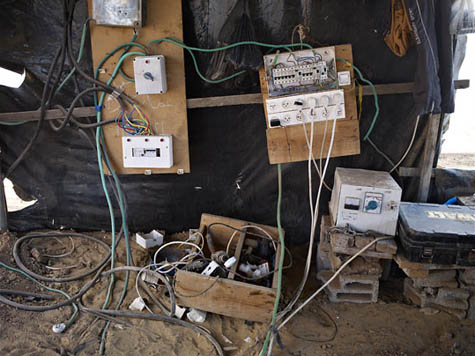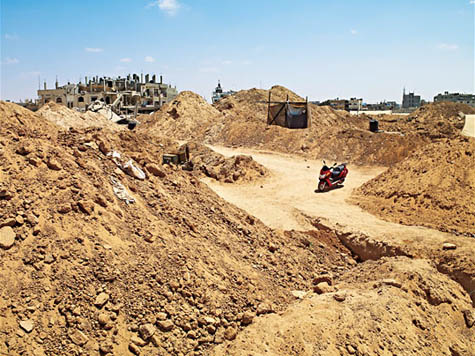Subeconomic Space
 [Image: Photo by Richard Mosse, from Time magazine].
[Image: Photo by Richard Mosse, from Time magazine].Photographer Richard Mosse, who BLDGBLOG has interviewed in the past and who is one of many participants in this autumn's "Landscapes of Quarantine" design studio, has just published a new series of photographs in Time magazine documenting the flow of goods into and out of the Gaza Strip.
This economic flow is literally underground, however, as it passes beneath the supervision of both Israel and Egypt, through a network of often quite sophisticated tunnels; channeled under pressure through tiny pores, it exhibits a surprisingly low viscosity, we might say.
"The tunnels vary in size and scale," journalist Abigail Hauslohner explains in the accompanying article. "Some are fragile dirt shafts; others feature wide, wood-reinforced passageways." There are, according to the users and builders of these spaces, "hundreds of tunnels—some weaving right over one another at different depths—that are mostly used to import commercial goods that range from food and baby formula to computers and even cars." Livestock is frequently herded across the border, through electrically lit tunnels, sometimes uphill.
"Centered around the town of Rafah," Hauslohner explains, these tunnels "are virtually the only way that goods have reached the residents of the tiny territory since 2002, when Hamas took control of it and Israel imposed a blockade on the its land and sea borders."
 [Image: Flexible infrastructure: "The tunnels' electric and phone systems are a study in improvisation," we read; photo by Richard Mosse, from Time magazine].
[Image: Flexible infrastructure: "The tunnels' electric and phone systems are a study in improvisation," we read; photo by Richard Mosse, from Time magazine].The required physical infrastructure for these constructions spills out to include "warehouses that sell the tools used to physically shape the tunnel industry: shovels, rope, pulleys and electrical cords, plus pickaxes, hammers, nuts, bolts and screws in all sizes. The industry of making the tunnels is a booming business on its own."
In the following image we see "tunnel heads," where the subterranean structures breach the Earth's surface and allow exit or entry.
 [Image: "Dirt from the digging litters the landscape," Time explains. "The smugglers say that Israel's blockade gives them no choice. Says one Rafah shopkeeper, 'Even if Israel destroys all of the tunnels entirely, I'm quite sure that the they will only be dug again and again.'" Photo by Richard Mosse, from Time magazine].
[Image: "Dirt from the digging litters the landscape," Time explains. "The smugglers say that Israel's blockade gives them no choice. Says one Rafah shopkeeper, 'Even if Israel destroys all of the tunnels entirely, I'm quite sure that the they will only be dug again and again.'" Photo by Richard Mosse, from Time magazine].Check out the rest of the photographs over at Time; but be sure to browse through Mosse's own website for some other, incredible work.





Comments are moderated.
If it's not spam, it will appear here shortly!
Post a Comment